“‘Them’ Is Pure Degradation Porn,” a recent review of Amazon Prime’s newest foray into black horror cinema declares. I wish that had been true.
Them is the story of a black middle-class family, the Emorys, taking place over the course of ten days in 1953. After experiencing a traumatic act of anti-black violence in their home state of North Carolina—an act which haunts the rest of the series—the Emorys flee to the white, middle-class suburb of Compton, California. The family soon meets their white neighbors, whose rage and disgust at integration results in steadily escalating acts of violent harassment. At one point the Emorys’ home is draped with dozens of lynched dolls that the family must brush through on their way to work and school. By the end of the series, the violence has turned physical. In addition to this rote anti-blackness, however, all four Emorys—Livia, the mother; Henry, the father; and their two daughters—are also haunted by their own personal supernatural specters. The result is a swirling maelstrom of cruelty that never gives the Emorys—or the viewer –space to breathe. Two moments of violence in particular—a black woman is raped while her baby is bludgeoned to death, and a black couple is blinded by a hot poker, lynched and burned—are, on the face of it, so grotesque as to seemingly earn the show the title of “torture porn”—the gag-inducing horror subgenre that includes gore masterworks like Saw and Ichi the Killer.
Them’s blend of supernatural horror and realist racial violence is not new, although that may surprise some. 2017’s Get Out—Jordan Peele’s award-winning juxtaposition of Obama-era racial discourse and pulpy horror conventions—emerged into the cultural mainstream like the vision of an unimagined future. But Get Out was simply the latest exercise in a long history of black horror cinema, stretching from Tales from the Hood (1995) to Blacula (1972) to Son of Ingagi (1940). What made Get Out stand out was its centrality in the public consciousness, a centrality that “legitimized,” rather than created, black horror. Since then, not only Blumhouse (Get Out), but Lionsgate (Antebellum), Netflix (His House, Atlantics) and Hulu (Bad Hair) have gotten into the business of black horror. With Them, Amazon Prime joins the pack.
This latest foray, however, has not elicited the overwhelming praise lavished upon Get Out; rather, it has been met with a considerable degree of disgust and disdain. I understand the reaction. Them is sleek, polished to a slick sheen by steady directing, pithy writing and the kind of production budget only a studio like Amazon could provide. But that sleekness often feels rote and uninteresting. The show isn’t as witty as Get Out, as expertly crafted as His House or as lovely as Atlantics. (Then again, neither are horror classics like Blacula, or Friday the 13th.) But the criticisms of Them have largely centered on a crime as moral as it is aesthetic. A piece in the Atlantic asks, simply and tellingly, “Who Wants to Watch Black Pain?” Them, the refrain goes, is obsessed with depicting—exploiting—the suffering of black folks, at a scale hitherto unseen in the latest wave of black horror (except, perhaps, with Lionsgate’s similarly criticized Antebellum). And the show’s decision to depict such moments of violence (and to do so with such temerity) has been roundly condemned.
The reasons for this criticism are rather complex. First, it’s clear that the show has the potential to negatively affect black viewers. Was Little Marvin, the creator of the show, simply playing the role of sadist, poking and prodding at black psyches in hopes of inducing vomit and anxiety attacks? He insists otherwise. In a frequently cited interview, Marvin says the following:
What I’ve come to realize is that I wanted a scene that would rip through the screen, grab the viewer by the jugular and force them to contend with a history of violence against Black bodies in this country. If I did that in a way that you’ve seen before—like an act of police brutality or a slave narrative—that in some way creates a distance or a salve for a viewer.
The depictions of black suffering in the show, in other words, have a didactic purpose. That is, they exist to instruct, to “force [the viewer] to contend with” anti-blackness. But, as Angelica Jade Bastién sharply argues in Vulture, Marvin’s color-blind evocation of a “viewer” seems naive at best, and duplicitous at worst. Simply: black viewers already contend with anti-blackness everyday. We’re in no need, she argues, of education. (This, for what it’s worth, does seem to smack of an odd kind of cultural essentialism, and reduces, say, the extensive reams of black theorizing and empirical research to mere instruments for white education; is this fair? Nonetheless:) Thus, the purpose of the aestheticization of black suffering—to educate—reveals that that aestheticization is implicitly for non-black viewers.
Other writers have similarly condemned the instrumentalization of black suffering. These condemnations can be divided into two basic arguments. First, one might (and many do) argue that the aestheticization of that suffering does not, in fact, serve to radicalize non-black viewers. While artworks like Them may change white minds cosmetically, they often become a minstrel show, offering a simple kind of moral education that further dehumanizes the instruments of that education. And second, one might (and many do) point out that the didactic work black suffering purportedly does for non-black viewers coexists with the trauma it induces in black viewers. This trauma therefore becomes a kind of casualty of war, a necessary cost of the supposedly honorable work of “consciousness-raising” (work that might, as suggested above, itself be a failure). The experiences of actual black folks become immaterial for a purportedly “black” work of art.
The conjunction of trauma with didactic impotence is cited as a reason for the apparent lack of need or desire in black folks to view such representations. “Who Wants to Watch Black Pain?” Non-black people, not black people, it seems. We are offered a formula—black suffering offers instruction and trauma; black people have no need of instruction; thus, all such depictions offer to us is trauma; thus, black folks have no need for them—that emerges as a kind of unquestioned given. It serves, I think, as a ground, or limit, for black cinematic criticism, and not just for Them.
But this formula is questionable, to say the least. Need the aestheticization of black suffering be either traumatic or instructive? What about the possibility of its wicked, out-of-control pleasure? The precise crime of Them is that it erases the possibility of this sort of sinful erotics.
●
The penultimate episode of Them, “COVENANT II,” is the series’ most artistically accomplished. Flashing back to the postbellum 1800s, the episode reveals the cause of the supernatural evil haunting the Emorys. It is also one of two episodes to receive a content warning for “graphic violence” (the first being episode five, “COVENANT I”). In “COVENANT II,” a black couple stumbles upon a fundamentalist white immigrant community settling the American West. Encouraged by the community’s patriarch, the couple decides to temporarily settle there. Eventually, in order to repay their hosts’ kindness, the couple agrees to labor for them for free. This becomes a fatal decision; they are seen first as slaves and then, as the patriarch’s grasp on reality begins to slip, as inhuman devils threatening the physical and spiritual health of the community. After a failed escape attempt, the enraged patriarch demands that, in order to quash their evil, the two must be submitted to the Lord’s justice. And so they are blinded, hanged and burned.
Before watching this episode, I had been prepared for what was said to be a grisly, gratuitous sequence of torture. This blinding and lynching had been repeatedly cited by critics as evidence of Them’s exploitation of black suffering, an exploitation that, as we have seen, is said to be performed for didactic purposes. I expected to see what Saidiya Hartman calls “a scene of subjection,” a vicious and grotesquely bald-faced performance of anti-black violence. And in a way I did; but not as I expected.
As the scene begins, the black couple are forced to their knees by their captors. A white man stokes a fire, stops and raises a poker, glowing white with heat, into the frame. The score gives us a menacing thud, to get the message across. The man proceeds toward the couple, with the camera over his shoulder, the poker hovering in the foreground over the black man, who is blurry in the background. (The choreography is reminiscent of the famous, and brilliant, opening of La Maschera del Demonio.)
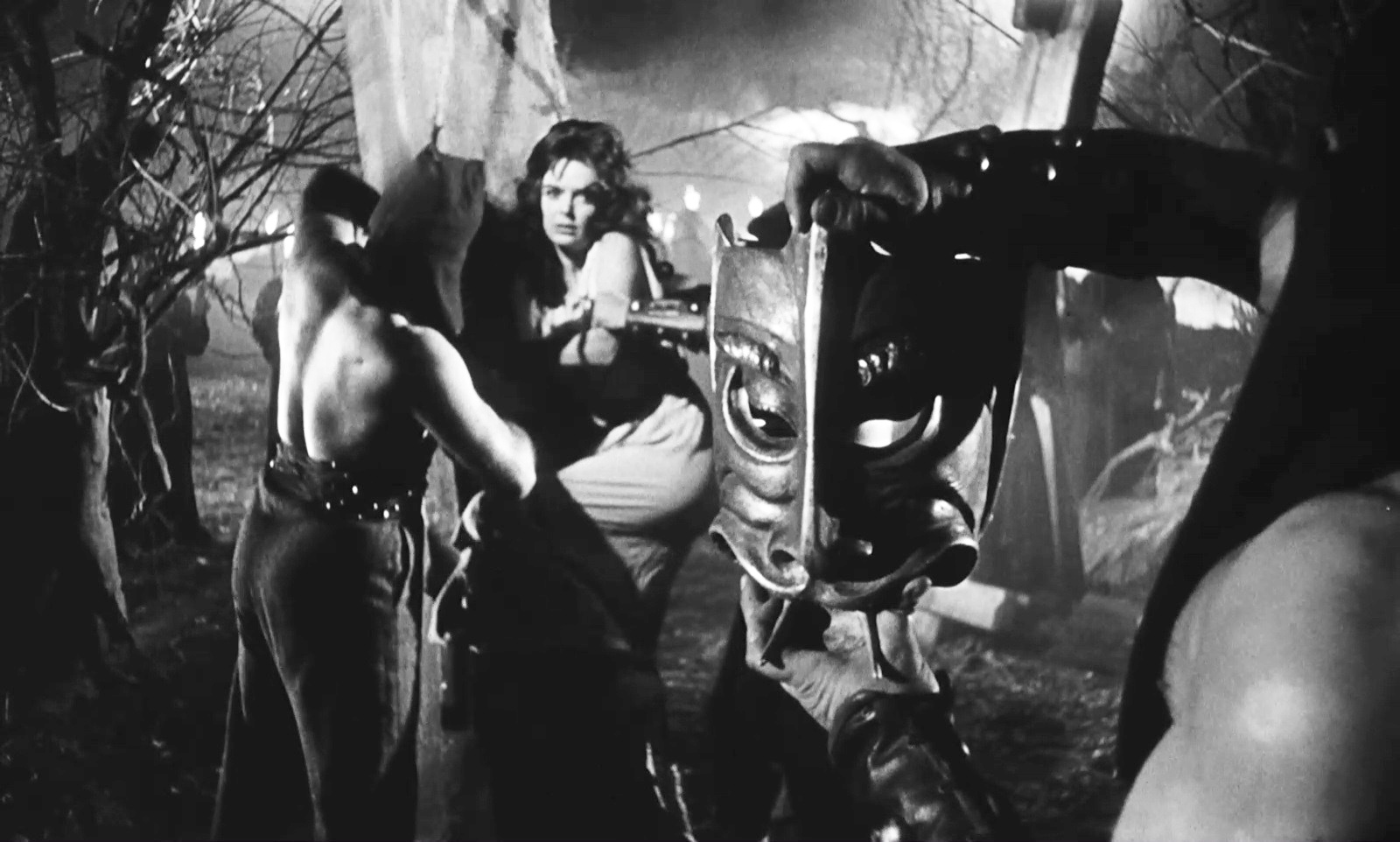
La Maschera del Demonio
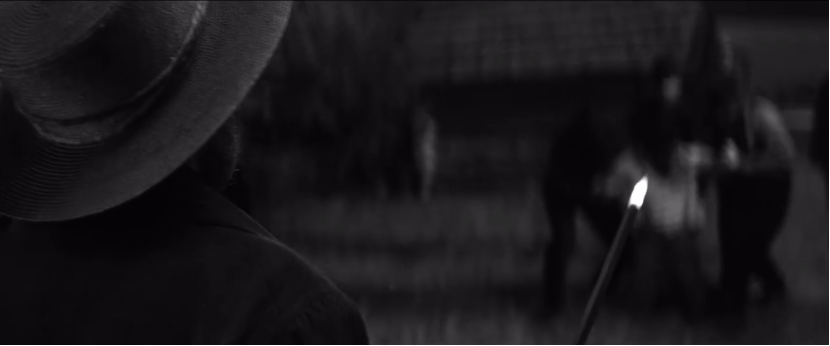
COVENANT II
As the patriarch intones in voice-over, “God may inflict you with blindness,” the camera moves behind the shoulder of the black man. The white man brings the poker closer and closer. But from this position, we are unable to actually see him pierce his victim’s eye. This suspenseful foreplay, however, is merely anticipating, as does any good horror film, the “money shot,” the moment of brutal violence itself. Seemingly right on schedule, the camera cuts again, now behind the white man’s shoulder as he angles the poker, moves in, and—
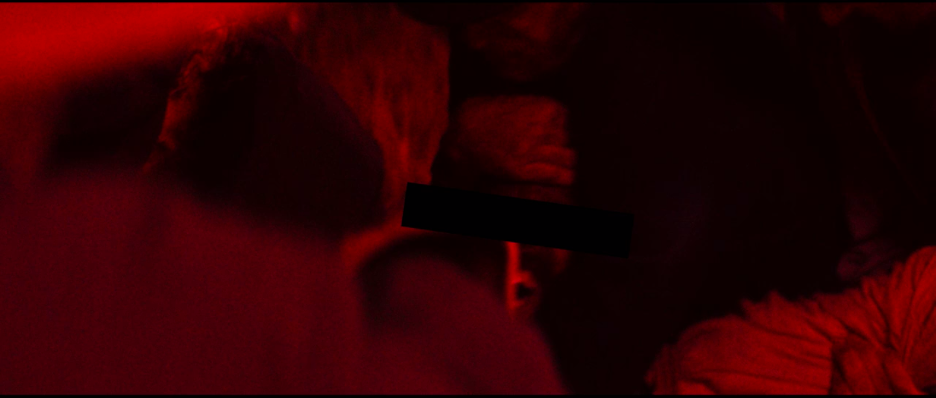
All of a sudden, seconds before the money shot itself, the camera freezes into a still frame; the image is shaded with a lurid (and visually impenetrable) red; and the eyes are covered up by a black bar. The sound continues, however: we hear a sizzle, and the black man’s scream. This is immediately repeated as his second eye is burned. Then, after shots of the black woman screaming in anticipation and the patriarch reading scripture, we see the aftermath of the event: an unflinching shot of the black woman, “gazing” up, her face screwed up in pain, as the bubbling, raised craters that once held her eyes are lit by stark lamplight.
Them shows us the foreplay; it shows us the postcoital wreckage. But it actively, aggressively refuses to show us the money shot. My use of pornographic terminology is no accident. Cynthia Freeland brilliantly compares the structure of horror movies to the pornographic narrative arc. Both the horror film and the porn film are usually structured around a climax, a moment that haunts and structures the entire proceeding. Climax is the promise of both, and its eventual appearance—Michael Myers’s brutal stabbing of his sister in the opening of Halloween, the mangling of the witch’s face in La Maschera—is visually foregrounded.
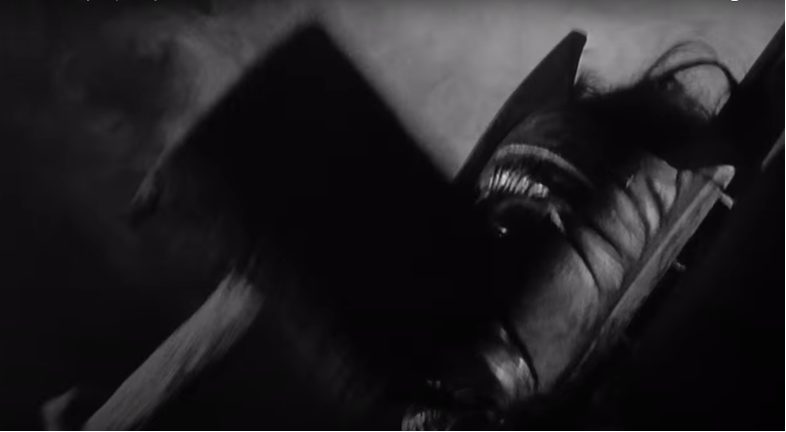
La Maschera’s money shot
And yet, in “COVENANT II,” this telos, that which the scene in question is oriented toward, is literally covered up with a black bar. The actual moment of violence is not shown; not only that, but it is conspicuously not shown. Many a horror film has escaped the censors with clever editing—in the famous shower scene in Psycho, Hitchcock’s frenetic editing never once allows us to see the knife actually enter Marion Crane’s body. But rather than merely cutting away from the money shot, “COVENANT II” tries to show it by hiding it, to draw attention to it without actually fulfilling the promise of spectacular violence that the gaze demands.
Compare this, if one needs a counterexample, to the absurdly gonzo eye-piercing scene of Lucio Fulci’s gore masterpiece Zombi 2.
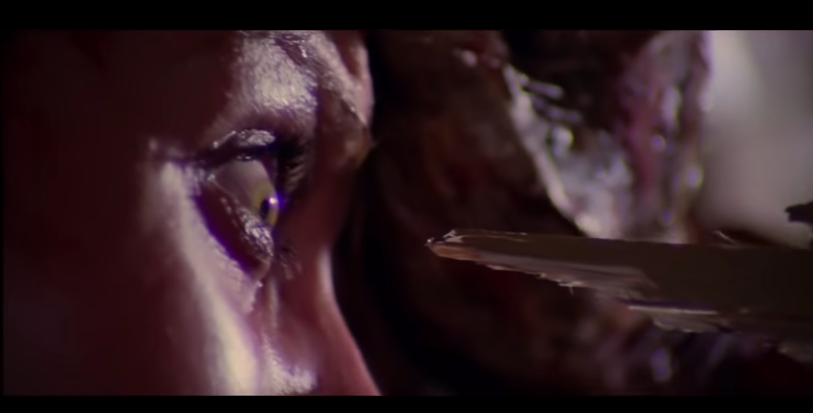
Zombi 2
Neither clever editing nor dramatic self-censorship stands in the way of the money shot here. The human eyeball is ravaged with impunity, Fulci’s camera in close-up the entire time to capture every ooze. I’m not suggesting (not yet, anyway) that “COVENANT II” ought to have done this. But the difference is clear; and it raises the question: Why, when this alternative choice exists, did Little Marvin so intentionally avoid it?
This question becomes more pressing when we remember that Little Marvin was explicitly committed to showing the event of anti-black violence! That is, apparently, his entire aim: to allow no “distance” or “salve” when it comes to black suffering, to heroically present it to the viewer in its most immediate form. And yet, when given the clearest and sharpest opportunity to do so, he not only undercuts his claimed intention, but does so with a heavy-handed self-reflexivity.
What are we to make of this? Does Them just fail according to its own logics? Did Little Marvin secretly preempt his future critics? And an entangled question: What, if my descriptions ring true, are his critics so opposed to? If this scene is actually missing the money shot, then what is so objectionable, or gratuitous, about it?
The answer to these questions lies as much in what the scene does show as in what it doesn’t. The money shot is preceded by forty minutes of foreplay. We see the transformation of the black couple’s presence in the insular community, the dips and turns of their host’s perception of them. Crucially, we receive a deep and complex characterization of the patriarch. Each of his actions is rendered predictable by a comprehensible twist of fate. “COVENANT II” is not just teleologically structured by the climactic moment of violence; it is teleologically structured by the attempt to explain it, to provide an intelligible reason for it. In this sense—by focusing on reasons, justifications and consequences, rather than the event itself—it seeks to make the violence comprehensible.
As such, Them does not show black suffering in its most brute, material form. It does not show the kind of suffering horror generally shows, namely gratuitous, grotesque violence. Instead, it dances around pain and, when forced to directly contend with it, intentionally covers it up. I don’t think this is an accident. I think this is a direct consequence of Them’s obsession with didactics. Them wants to teach. And to teach in this sense is to provide explanations and to sketch consequences: to make something comprehensible. In this case, to make anti-black violence comprehensible means to reveal its causes and effects. So Them lingers on every “nigger,” painstakingly sketches out the process of redlining and leeringly swallows up the sobs and screams and ravaged bodies that follow (recall that in the poker scene, the man’s scream was not censored as its cause was). That is what it wishes to teach us: what anti-black violence does, and where it comes from. But the actual brutal moment of physical violence—that which makes the scene possible at all—escapes from the scene of subjection. For a filmmaker apparently committed to an almost edgelord honesty, this erasure is odd, and telling.
Telling, because there’s a danger housed in the moments Them elides, a danger it is well aware of and wishes to avoid. This is the danger of incomprehensibility, of opacity, of absurdity. Return to Fulci’s sadism. This is a sadism sans didactics; any moral instruction this scene could offer is quickly overwhelmed by the brutality and senselessness of the violence it stages. No narrative—or, for that matter, moral—reason could justify the loving brutality with which Fulci’s victim suffering is staged; it outstrips any contribution to the causal mechanisms of the narrative (a narrative that, in Them, is specifically designed to make anti-blackness an object of instruction). The woman in Zombi 2 is killed by a zombie; we did not need to see a close-up of her eye bubble green pus as it is lanced by a shaft of wood to learn that! And yet, we do see it. The violence emerges as excess, beyond the logics of narrative: or, more precisely in the case of Them, beyond the logics of anti-black violence.
As I watched this scene, I knew what was coming: the narrative of anti-black violence could only lead one place. But there remained an element of undecidability that kept me watching, that kept me dreaming. There was the promise that, in a few short moments, the narrative would fall away, as a maw of absurdity, of gratuity, of fetid materiality, opened up at the precise moment of excess. I sat waiting for Them to finally acknowledge the limitations of narrative necessity and to embrace strangeness, unfamiliarity. My disappointment when I saw the money shot so ruthlessly and coldly excised was sharp and sobering. Trapped within the logic of a story I’d heard too many times before, I had nowhere to go.
Them is no degradation porn. It doesn’t have the imagination.
●
What if Them—and black (horror) cinema in general—rejected the responsibility to instruct and accepted excess as an aesthetic mode? Would black horror, and the aesthetic possibilities of black suffering, still find itself limited by the two poles of didacticism and trauma? I don’t think so. Excess is capable of alchemically transforming what, in Little Marvin’s hands, can only be a belabored, anxiety-inducing history lesson. Excess could have transformed Them into a television show obsessed with black pleasure, rather than white instruction. For that would be a show that trusts, appreciates and loves its black viewers, that sees them not merely as social critics or casualties of instruction but in their—in our—wild, unbound, limitless capacities for pleasure.
Such alternatives can be found, outside and within horror—often at the underside of cinema, beyond the controlling limitations of the mainstream. Imagine, say, the anarchic aesthetics of blaxploitation classics like Tales from the Hood. Like Little Marvin, Tales’s director Rusty Cundieff has admitted, in interviews, to having a didactic aim. And this is quite clear in the film; consisting of a series of vignettes, all centering on reimagining incidents of structural racism using horror iconography, Tales from the Hood has a Point, a Moral, a Message. That is to say, Tales from the Hood is not the complete antithesis of Them; yet it reveals that the history of black horror can nonetheless contain a fugitive fugue, a strain of excess that Them obsessively denies.
Take the second vignette. Most of the violence in Tales is suffered by white people and is presented as “just deserts” for their crimes. Yet in the second vignette, an abusive black man is ultimately killed by his long-suffering stepson. While directed at a black individual, the violence is understandable as punishment for his abusive behavior. Nonetheless, excess smuggles in as it never does for Little Marvin; black suffering carries with it the promise of more than a morality lesson. The central conceit of the play is that the boy has fantastically imagined his stepfather, Carl, as a monster, one he crudely draws. At the climax of the story, as Carl beats his mother, the boy transforms the drawing into a poppet (a doll, often erroneously called a “voodoo doll,” used in magic practice as a signifier of a human entity). The boy folds the paper, so that the crease cuts right through the monster’s arm. Suddenly, Carl’s arm bends impossibly as he screams in pain, mimicking the poppet’s mutilation.
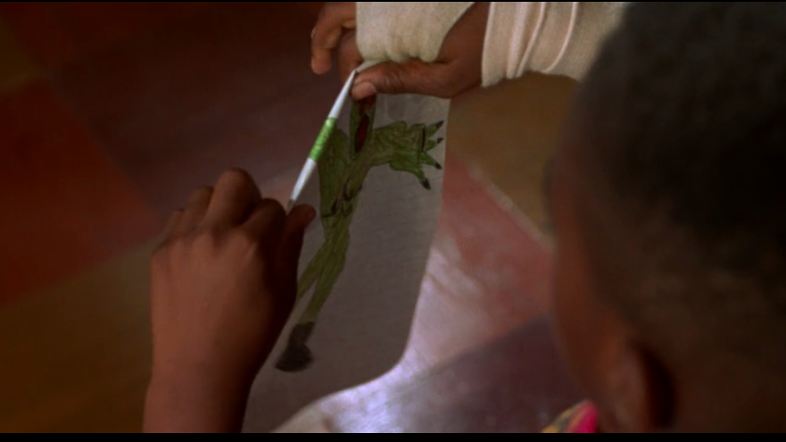
The foreplay…
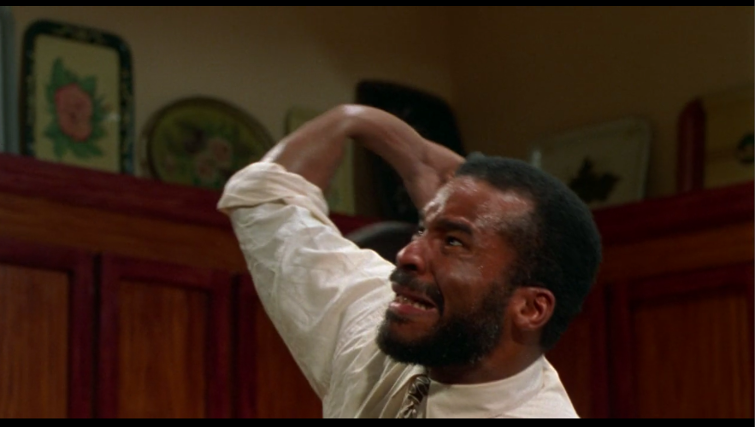
…and the money shot
The boy continues to fold and crumble the paper, until Carl is reduced into a physically impossible jumble of mutilated flesh, who, comically, sputters out, “This ain’t over yet, bitch.” We see every twist, every absurd wrench of Carl’s body, every money shot, in real time; Cundieff takes liberal advantage of practical effects to make sure nothing is left to the imagination.
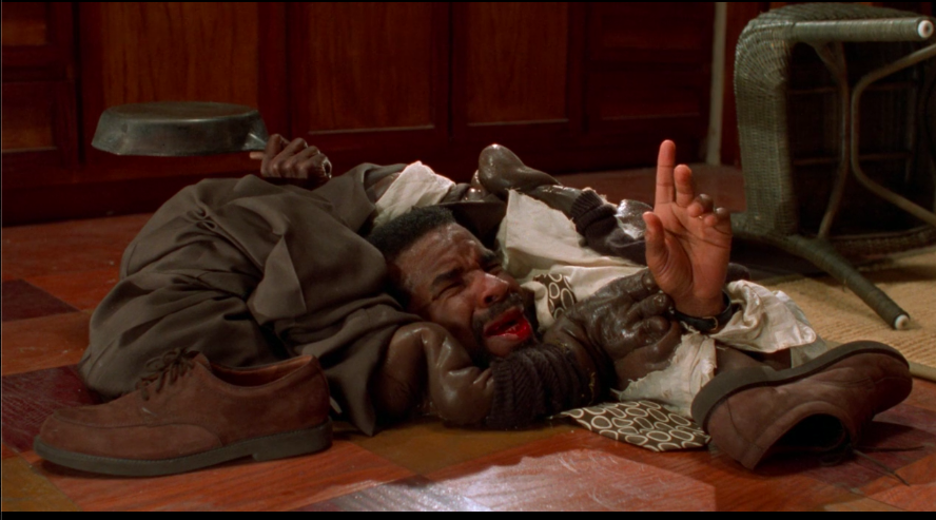
The stepfather post-coitus
The entire sequence is absurd, laughable, over the top, unbelievable, campy, ridiculous…excessive. And something happens to the viewer because of it. The narrow confines of the morality play burst open, undone by gratuity. Horror, for Cundieff, is more than a moral metaphor. It is an aesthetic practice, one defined by excess for excess’s sake. It is a way of seeing, and experiencing, and loving blackness beyond its instructive capacities.
Save exceptions such as this scene, this otherwise possibility of black cinematic excess largely remains in our imagination. But it need not remain here forever.
“‘Them’ Is Pure Degradation Porn,” a recent review of Amazon Prime’s newest foray into black horror cinema declares. I wish that had been true.
Them is the story of a black middle-class family, the Emorys, taking place over the course of ten days in 1953. After experiencing a traumatic act of anti-black violence in their home state of North Carolina—an act which haunts the rest of the series—the Emorys flee to the white, middle-class suburb of Compton, California. The family soon meets their white neighbors, whose rage and disgust at integration results in steadily escalating acts of violent harassment. At one point the Emorys’ home is draped with dozens of lynched dolls that the family must brush through on their way to work and school. By the end of the series, the violence has turned physical. In addition to this rote anti-blackness, however, all four Emorys—Livia, the mother; Henry, the father; and their two daughters—are also haunted by their own personal supernatural specters. The result is a swirling maelstrom of cruelty that never gives the Emorys—or the viewer –space to breathe. Two moments of violence in particular—a black woman is raped while her baby is bludgeoned to death, and a black couple is blinded by a hot poker, lynched and burned—are, on the face of it, so grotesque as to seemingly earn the show the title of “torture porn”—the gag-inducing horror subgenre that includes gore masterworks like Saw and Ichi the Killer.
Them’s blend of supernatural horror and realist racial violence is not new, although that may surprise some. 2017’s Get Out—Jordan Peele’s award-winning juxtaposition of Obama-era racial discourse and pulpy horror conventions—emerged into the cultural mainstream like the vision of an unimagined future. But Get Out was simply the latest exercise in a long history of black horror cinema, stretching from Tales from the Hood (1995) to Blacula (1972) to Son of Ingagi (1940). What made Get Out stand out was its centrality in the public consciousness, a centrality that “legitimized,” rather than created, black horror. Since then, not only Blumhouse (Get Out), but Lionsgate (Antebellum), Netflix (His House, Atlantics) and Hulu (Bad Hair) have gotten into the business of black horror. With Them, Amazon Prime joins the pack.
This latest foray, however, has not elicited the overwhelming praise lavished upon Get Out; rather, it has been met with a considerable degree of disgust and disdain. I understand the reaction. Them is sleek, polished to a slick sheen by steady directing, pithy writing and the kind of production budget only a studio like Amazon could provide. But that sleekness often feels rote and uninteresting. The show isn’t as witty as Get Out, as expertly crafted as His House or as lovely as Atlantics. (Then again, neither are horror classics like Blacula, or Friday the 13th.) But the criticisms of Them have largely centered on a crime as moral as it is aesthetic. A piece in the Atlantic asks, simply and tellingly, “Who Wants to Watch Black Pain?” Them, the refrain goes, is obsessed with depicting—exploiting—the suffering of black folks, at a scale hitherto unseen in the latest wave of black horror (except, perhaps, with Lionsgate’s similarly criticized Antebellum). And the show’s decision to depict such moments of violence (and to do so with such temerity) has been roundly condemned.
The reasons for this criticism are rather complex. First, it’s clear that the show has the potential to negatively affect black viewers. Was Little Marvin, the creator of the show, simply playing the role of sadist, poking and prodding at black psyches in hopes of inducing vomit and anxiety attacks? He insists otherwise. In a frequently cited interview, Marvin says the following:
The depictions of black suffering in the show, in other words, have a didactic purpose. That is, they exist to instruct, to “force [the viewer] to contend with” anti-blackness. But, as Angelica Jade Bastién sharply argues in Vulture, Marvin’s color-blind evocation of a “viewer” seems naive at best, and duplicitous at worst. Simply: black viewers already contend with anti-blackness everyday. We’re in no need, she argues, of education. (This, for what it’s worth, does seem to smack of an odd kind of cultural essentialism, and reduces, say, the extensive reams of black theorizing and empirical research to mere instruments for white education; is this fair? Nonetheless:) Thus, the purpose of the aestheticization of black suffering—to educate—reveals that that aestheticization is implicitly for non-black viewers.
Other writers have similarly condemned the instrumentalization of black suffering. These condemnations can be divided into two basic arguments. First, one might (and many do) argue that the aestheticization of that suffering does not, in fact, serve to radicalize non-black viewers. While artworks like Them may change white minds cosmetically, they often become a minstrel show, offering a simple kind of moral education that further dehumanizes the instruments of that education. And second, one might (and many do) point out that the didactic work black suffering purportedly does for non-black viewers coexists with the trauma it induces in black viewers. This trauma therefore becomes a kind of casualty of war, a necessary cost of the supposedly honorable work of “consciousness-raising” (work that might, as suggested above, itself be a failure). The experiences of actual black folks become immaterial for a purportedly “black” work of art.
The conjunction of trauma with didactic impotence is cited as a reason for the apparent lack of need or desire in black folks to view such representations. “Who Wants to Watch Black Pain?” Non-black people, not black people, it seems. We are offered a formula—black suffering offers instruction and trauma; black people have no need of instruction; thus, all such depictions offer to us is trauma; thus, black folks have no need for them—that emerges as a kind of unquestioned given. It serves, I think, as a ground, or limit, for black cinematic criticism, and not just for Them.
But this formula is questionable, to say the least. Need the aestheticization of black suffering be either traumatic or instructive? What about the possibility of its wicked, out-of-control pleasure? The precise crime of Them is that it erases the possibility of this sort of sinful erotics.
●
The penultimate episode of Them, “COVENANT II,” is the series’ most artistically accomplished. Flashing back to the postbellum 1800s, the episode reveals the cause of the supernatural evil haunting the Emorys. It is also one of two episodes to receive a content warning for “graphic violence” (the first being episode five, “COVENANT I”). In “COVENANT II,” a black couple stumbles upon a fundamentalist white immigrant community settling the American West. Encouraged by the community’s patriarch, the couple decides to temporarily settle there. Eventually, in order to repay their hosts’ kindness, the couple agrees to labor for them for free. This becomes a fatal decision; they are seen first as slaves and then, as the patriarch’s grasp on reality begins to slip, as inhuman devils threatening the physical and spiritual health of the community. After a failed escape attempt, the enraged patriarch demands that, in order to quash their evil, the two must be submitted to the Lord’s justice. And so they are blinded, hanged and burned.
Before watching this episode, I had been prepared for what was said to be a grisly, gratuitous sequence of torture. This blinding and lynching had been repeatedly cited by critics as evidence of Them’s exploitation of black suffering, an exploitation that, as we have seen, is said to be performed for didactic purposes. I expected to see what Saidiya Hartman calls “a scene of subjection,” a vicious and grotesquely bald-faced performance of anti-black violence. And in a way I did; but not as I expected.
As the scene begins, the black couple are forced to their knees by their captors. A white man stokes a fire, stops and raises a poker, glowing white with heat, into the frame. The score gives us a menacing thud, to get the message across. The man proceeds toward the couple, with the camera over his shoulder, the poker hovering in the foreground over the black man, who is blurry in the background. (The choreography is reminiscent of the famous, and brilliant, opening of La Maschera del Demonio.)
La Maschera del Demonio
COVENANT II
As the patriarch intones in voice-over, “God may inflict you with blindness,” the camera moves behind the shoulder of the black man. The white man brings the poker closer and closer. But from this position, we are unable to actually see him pierce his victim’s eye. This suspenseful foreplay, however, is merely anticipating, as does any good horror film, the “money shot,” the moment of brutal violence itself. Seemingly right on schedule, the camera cuts again, now behind the white man’s shoulder as he angles the poker, moves in, and—
All of a sudden, seconds before the money shot itself, the camera freezes into a still frame; the image is shaded with a lurid (and visually impenetrable) red; and the eyes are covered up by a black bar. The sound continues, however: we hear a sizzle, and the black man’s scream. This is immediately repeated as his second eye is burned. Then, after shots of the black woman screaming in anticipation and the patriarch reading scripture, we see the aftermath of the event: an unflinching shot of the black woman, “gazing” up, her face screwed up in pain, as the bubbling, raised craters that once held her eyes are lit by stark lamplight.
Them shows us the foreplay; it shows us the postcoital wreckage. But it actively, aggressively refuses to show us the money shot. My use of pornographic terminology is no accident. Cynthia Freeland brilliantly compares the structure of horror movies to the pornographic narrative arc. Both the horror film and the porn film are usually structured around a climax, a moment that haunts and structures the entire proceeding. Climax is the promise of both, and its eventual appearance—Michael Myers’s brutal stabbing of his sister in the opening of Halloween, the mangling of the witch’s face in La Maschera—is visually foregrounded.
La Maschera’s money shot
And yet, in “COVENANT II,” this telos, that which the scene in question is oriented toward, is literally covered up with a black bar. The actual moment of violence is not shown; not only that, but it is conspicuously not shown. Many a horror film has escaped the censors with clever editing—in the famous shower scene in Psycho, Hitchcock’s frenetic editing never once allows us to see the knife actually enter Marion Crane’s body. But rather than merely cutting away from the money shot, “COVENANT II” tries to show it by hiding it, to draw attention to it without actually fulfilling the promise of spectacular violence that the gaze demands.
Compare this, if one needs a counterexample, to the absurdly gonzo eye-piercing scene of Lucio Fulci’s gore masterpiece Zombi 2.
Zombi 2
Neither clever editing nor dramatic self-censorship stands in the way of the money shot here. The human eyeball is ravaged with impunity, Fulci’s camera in close-up the entire time to capture every ooze. I’m not suggesting (not yet, anyway) that “COVENANT II” ought to have done this. But the difference is clear; and it raises the question: Why, when this alternative choice exists, did Little Marvin so intentionally avoid it?
This question becomes more pressing when we remember that Little Marvin was explicitly committed to showing the event of anti-black violence! That is, apparently, his entire aim: to allow no “distance” or “salve” when it comes to black suffering, to heroically present it to the viewer in its most immediate form. And yet, when given the clearest and sharpest opportunity to do so, he not only undercuts his claimed intention, but does so with a heavy-handed self-reflexivity.
What are we to make of this? Does Them just fail according to its own logics? Did Little Marvin secretly preempt his future critics? And an entangled question: What, if my descriptions ring true, are his critics so opposed to? If this scene is actually missing the money shot, then what is so objectionable, or gratuitous, about it?
The answer to these questions lies as much in what the scene does show as in what it doesn’t. The money shot is preceded by forty minutes of foreplay. We see the transformation of the black couple’s presence in the insular community, the dips and turns of their host’s perception of them. Crucially, we receive a deep and complex characterization of the patriarch. Each of his actions is rendered predictable by a comprehensible twist of fate. “COVENANT II” is not just teleologically structured by the climactic moment of violence; it is teleologically structured by the attempt to explain it, to provide an intelligible reason for it. In this sense—by focusing on reasons, justifications and consequences, rather than the event itself—it seeks to make the violence comprehensible.
As such, Them does not show black suffering in its most brute, material form. It does not show the kind of suffering horror generally shows, namely gratuitous, grotesque violence. Instead, it dances around pain and, when forced to directly contend with it, intentionally covers it up. I don’t think this is an accident. I think this is a direct consequence of Them’s obsession with didactics. Them wants to teach. And to teach in this sense is to provide explanations and to sketch consequences: to make something comprehensible. In this case, to make anti-black violence comprehensible means to reveal its causes and effects. So Them lingers on every “nigger,” painstakingly sketches out the process of redlining and leeringly swallows up the sobs and screams and ravaged bodies that follow (recall that in the poker scene, the man’s scream was not censored as its cause was). That is what it wishes to teach us: what anti-black violence does, and where it comes from. But the actual brutal moment of physical violence—that which makes the scene possible at all—escapes from the scene of subjection. For a filmmaker apparently committed to an almost edgelord honesty, this erasure is odd, and telling.
Telling, because there’s a danger housed in the moments Them elides, a danger it is well aware of and wishes to avoid. This is the danger of incomprehensibility, of opacity, of absurdity. Return to Fulci’s sadism. This is a sadism sans didactics; any moral instruction this scene could offer is quickly overwhelmed by the brutality and senselessness of the violence it stages. No narrative—or, for that matter, moral—reason could justify the loving brutality with which Fulci’s victim suffering is staged; it outstrips any contribution to the causal mechanisms of the narrative (a narrative that, in Them, is specifically designed to make anti-blackness an object of instruction). The woman in Zombi 2 is killed by a zombie; we did not need to see a close-up of her eye bubble green pus as it is lanced by a shaft of wood to learn that! And yet, we do see it. The violence emerges as excess, beyond the logics of narrative: or, more precisely in the case of Them, beyond the logics of anti-black violence.
As I watched this scene, I knew what was coming: the narrative of anti-black violence could only lead one place. But there remained an element of undecidability that kept me watching, that kept me dreaming. There was the promise that, in a few short moments, the narrative would fall away, as a maw of absurdity, of gratuity, of fetid materiality, opened up at the precise moment of excess. I sat waiting for Them to finally acknowledge the limitations of narrative necessity and to embrace strangeness, unfamiliarity. My disappointment when I saw the money shot so ruthlessly and coldly excised was sharp and sobering. Trapped within the logic of a story I’d heard too many times before, I had nowhere to go.
Them is no degradation porn. It doesn’t have the imagination.
●
What if Them—and black (horror) cinema in general—rejected the responsibility to instruct and accepted excess as an aesthetic mode? Would black horror, and the aesthetic possibilities of black suffering, still find itself limited by the two poles of didacticism and trauma? I don’t think so. Excess is capable of alchemically transforming what, in Little Marvin’s hands, can only be a belabored, anxiety-inducing history lesson. Excess could have transformed Them into a television show obsessed with black pleasure, rather than white instruction. For that would be a show that trusts, appreciates and loves its black viewers, that sees them not merely as social critics or casualties of instruction but in their—in our—wild, unbound, limitless capacities for pleasure.
Such alternatives can be found, outside and within horror—often at the underside of cinema, beyond the controlling limitations of the mainstream. Imagine, say, the anarchic aesthetics of blaxploitation classics like Tales from the Hood. Like Little Marvin, Tales’s director Rusty Cundieff has admitted, in interviews, to having a didactic aim. And this is quite clear in the film; consisting of a series of vignettes, all centering on reimagining incidents of structural racism using horror iconography, Tales from the Hood has a Point, a Moral, a Message. That is to say, Tales from the Hood is not the complete antithesis of Them; yet it reveals that the history of black horror can nonetheless contain a fugitive fugue, a strain of excess that Them obsessively denies.
Take the second vignette. Most of the violence in Tales is suffered by white people and is presented as “just deserts” for their crimes. Yet in the second vignette, an abusive black man is ultimately killed by his long-suffering stepson. While directed at a black individual, the violence is understandable as punishment for his abusive behavior. Nonetheless, excess smuggles in as it never does for Little Marvin; black suffering carries with it the promise of more than a morality lesson. The central conceit of the play is that the boy has fantastically imagined his stepfather, Carl, as a monster, one he crudely draws. At the climax of the story, as Carl beats his mother, the boy transforms the drawing into a poppet (a doll, often erroneously called a “voodoo doll,” used in magic practice as a signifier of a human entity). The boy folds the paper, so that the crease cuts right through the monster’s arm. Suddenly, Carl’s arm bends impossibly as he screams in pain, mimicking the poppet’s mutilation.
The foreplay…
…and the money shot
The boy continues to fold and crumble the paper, until Carl is reduced into a physically impossible jumble of mutilated flesh, who, comically, sputters out, “This ain’t over yet, bitch.” We see every twist, every absurd wrench of Carl’s body, every money shot, in real time; Cundieff takes liberal advantage of practical effects to make sure nothing is left to the imagination.
The stepfather post-coitus
The entire sequence is absurd, laughable, over the top, unbelievable, campy, ridiculous…excessive. And something happens to the viewer because of it. The narrow confines of the morality play burst open, undone by gratuity. Horror, for Cundieff, is more than a moral metaphor. It is an aesthetic practice, one defined by excess for excess’s sake. It is a way of seeing, and experiencing, and loving blackness beyond its instructive capacities.
Save exceptions such as this scene, this otherwise possibility of black cinematic excess largely remains in our imagination. But it need not remain here forever.
If you liked this essay, you’ll love reading The Point in print.